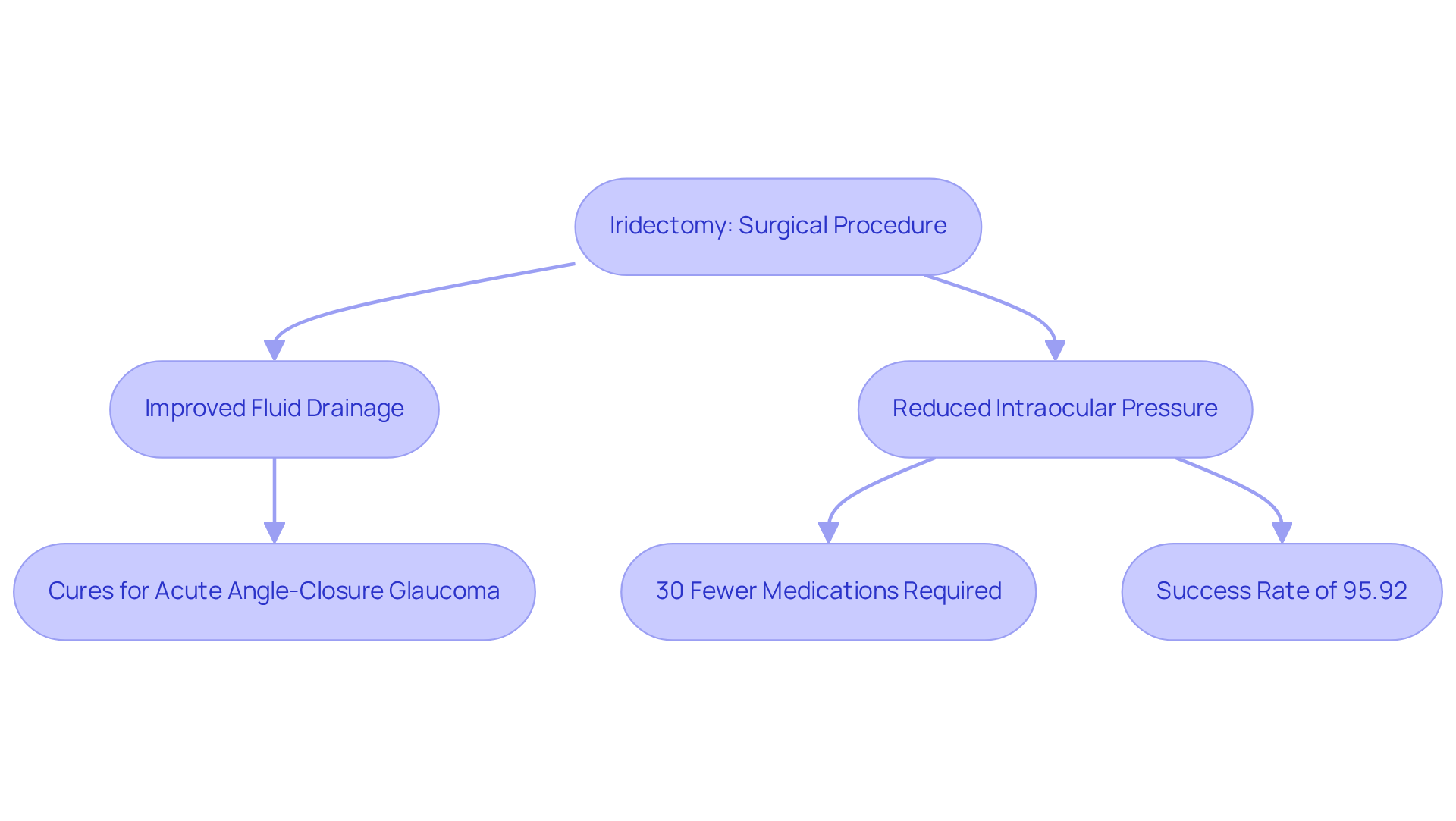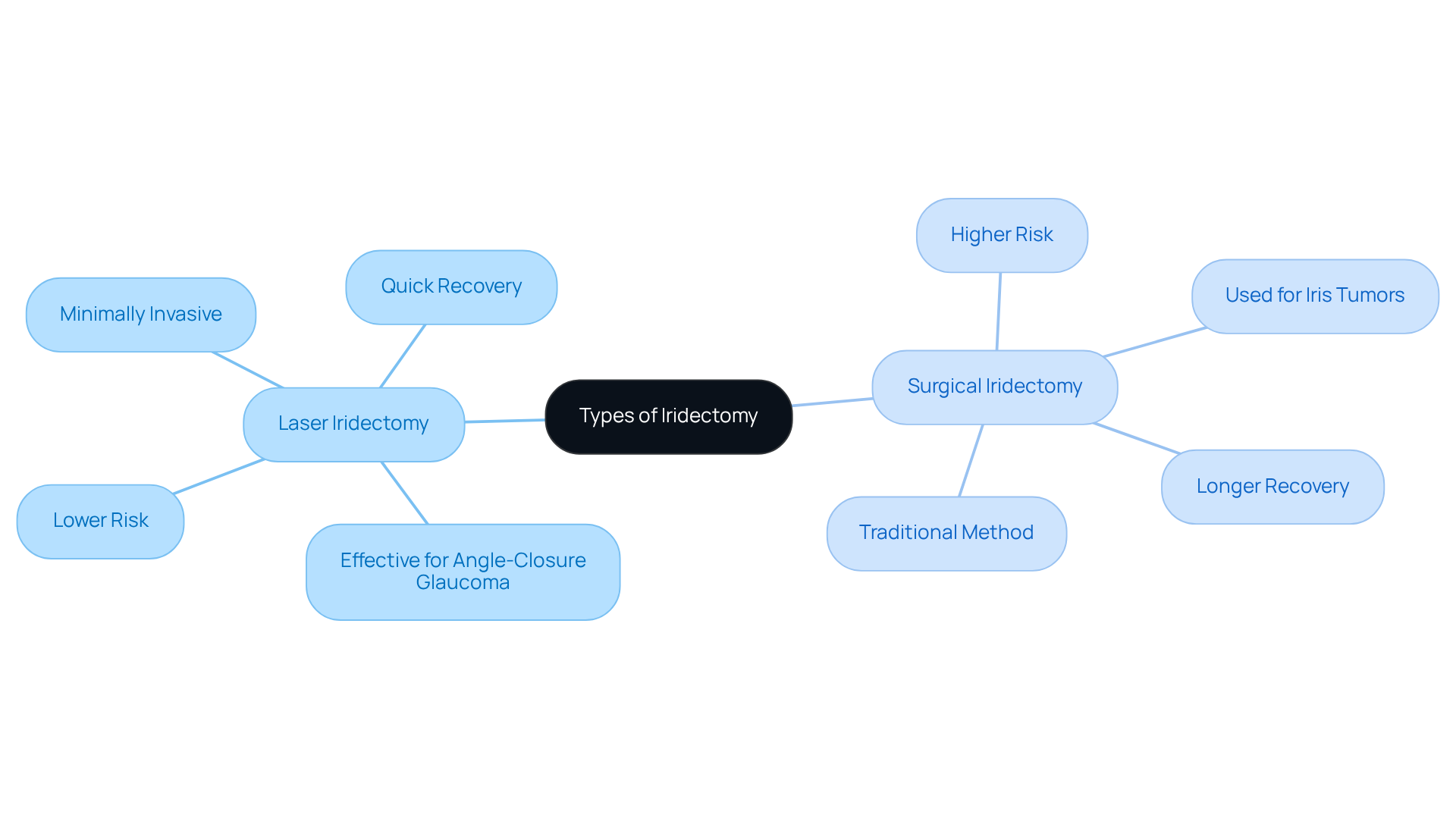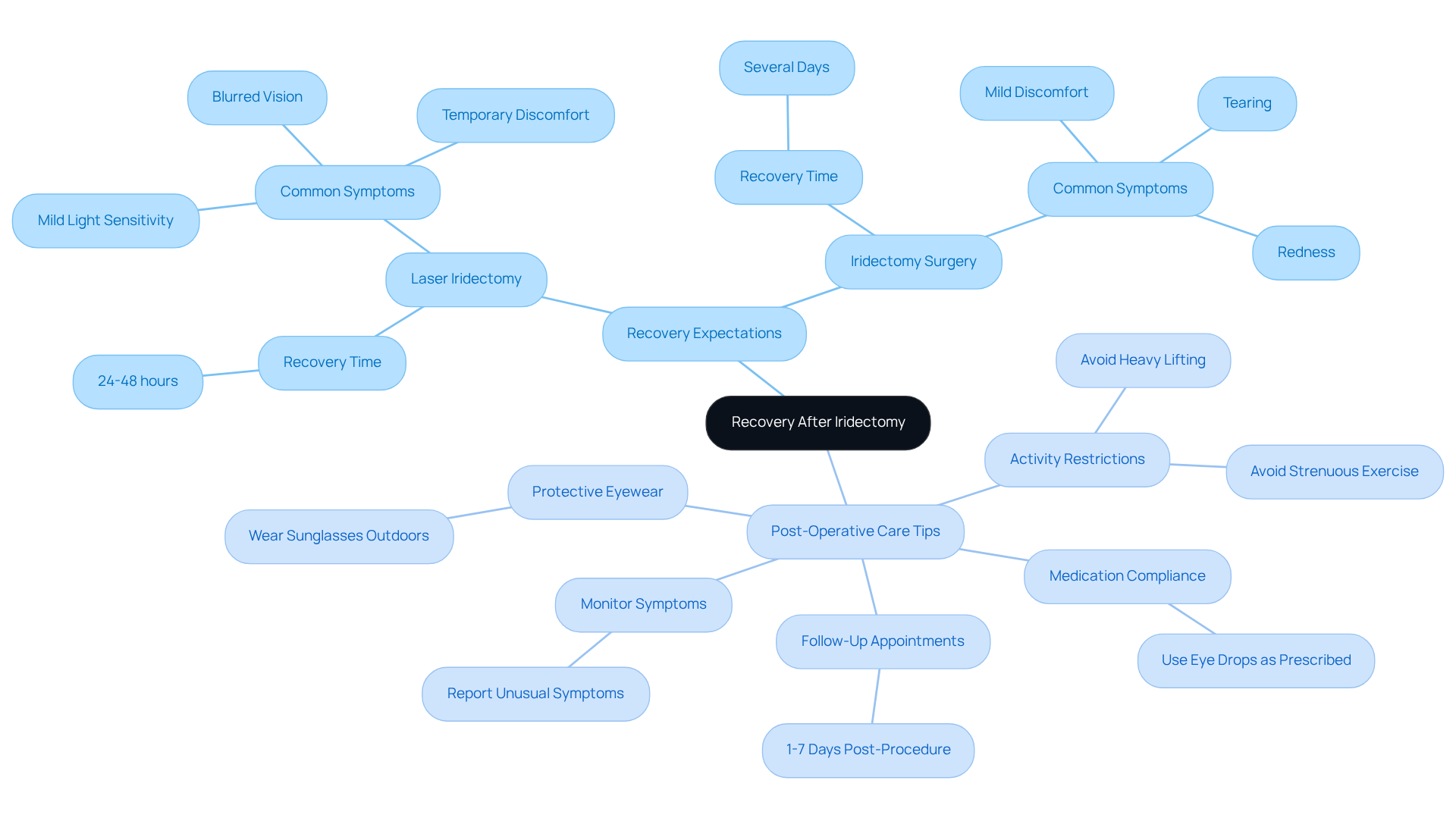Posted by: Northwest Eye in General on October 16, 2025
Overview
We understand that considering surgery can be a daunting experience, especially when it comes to your eye health. Iridectomy is a surgical procedure that involves the removal of a portion of the iris. This procedure primarily aims to treat conditions like glaucoma by improving fluid drainage and reducing intraocular pressure.
The significance of iridectomy is underscored by various statistics that demonstrate its effectiveness. For instance, it boasts a remarkable success rate of 95.92% in peripheral surgical interventions. Many patients also experience a notable reduction in the need for glaucoma medications, which can be a relief for those managing this condition.
We want to emphasize that this procedure plays a vital role in preserving vision and enhancing overall eye health. It’s common to feel uncertain about such decisions, but rest assured, we are here to help you through this process. Your well-being is our priority, and we encourage you to seek the care you deserve.
Introduction
Surgery can often bring about feelings of apprehension and curiosity, especially when it involves the delicate nature of eye health. We understand that the thought of undergoing a procedure can be daunting. Iridectomy, which involves the removal of a portion of the iris, is a crucial intervention for conditions like glaucoma. Managing intraocular pressure is vital for preserving your vision, and this procedure plays a significant role in that.
In this article, we will explore the intricacies of iridectomy. We will delve into its various types, the procedural steps involved, and recovery insights. It’s common to feel overwhelmed by the complexities of surgery, but rest assured, we are here to help you through this process. Together, we will navigate these challenges to ensure optimal outcomes for your eye health.
Define Iridectomy: Purpose and Importance in Eye Health
A surgical operation known as iridectomy involves the removal of a portion of the iris, which is the colored part of the eye. We understand that considering surgery can be daunting, especially when it relates to your vision. Iridectomy is primarily performed as an intervention to treat conditions such as glaucoma, where elevated intraocular pressure can lead to irreversible vision loss. The procedure known as iridectomy creates an opening in the iris, facilitating improved fluid drainage within the eye, effectively reducing pressure and preventing further complications. Iridectomy is a crucial procedure for preserving vision and enhancing overall eye health, making it a vital option for patients at risk of acute glaucoma attacks or other serious eye conditions.
The significance of this surgical procedure, specifically iridectomy, is highlighted by its effectiveness in managing glaucoma. Research shows that:
- 76% of patients treated with surgical intervention for primary acute angle-closure glaucoma were cured without requiring further medical therapy.
- A retrospective analysis showed that peripheral surgical intervention achieved a treatment success rate of 95.92%, significantly surpassing the 81.82% success rate noted in individuals undergoing compound trabeculectomy.
- 54% of eyes were managed by the surgical procedure alone after one year, and 33% after two years.
This emphasizes the technique’s importance in not only but also in maintaining visual function. Patients who underwent iridectomy required 30% fewer glaucoma medications compared to the 10% reduction in the medical treatment group, indicating its positive impact on patient management.
Besides glaucoma, an iridectomy may be necessary for other issues such as iris tumors or eye injuries. It’s common to feel uncertain about the best options available. David K. Gieser suggests laser eye surgery as a safer initial option compared to trabeculectomy, further highlighting the safety profile of the technique. Comprehending the purpose and advantages of the eye surgery enables patients to recognize the importance of the procedure and its potential to greatly enhance their eye health and quality of life. We are here to help you through this process, ensuring you feel informed and supported every step of the way.

Explore Types of Iridectomy: Laser vs. Surgical Techniques
We understand that considering eye surgery can be a daunting experience, and it’s important to know that there are two main categories of procedures available: laser and surgical.
- Laser Iridectomy: This minimally invasive technique employs a focused laser beam to create a small opening in the iris. Many patients prefer this option due to its quick recovery time and lower risk of complications. Laser surgery is particularly effective for treating angle-closure glaucoma, providing immediate relief of intraocular pressure by facilitating fluid drainage.
- Surgical iridectomy is a traditional method that involves making an incision in the eye to remove a segment of the iris. While it may be necessary in more complex situations or when laser treatment isn’t feasible, an iridectomy typically requires a and may carry a higher risk of complications. It’s often utilized in cases of iris tumors or severe glaucoma when other treatments have not succeeded.
Both techniques play a vital role in contemporary ophthalmology. The choice between them depends on the specific condition being addressed, your overall health, and the expertise of your surgeon. Remember, we are here to help you through this process and ensure you receive the best care possible.

Detail the Iridectomy Procedure: Step-by-Step Guide
The procedure for iridectomy can vary slightly depending on whether it is performed using laser techniques or traditional surgical methods. We understand that this can be a source of concern, and we aim to provide you with clear, supportive information to guide you through both methods.
Laser Iridectomy Procedure:
- Preparation: You will be positioned comfortably, and your eye will be numbed with topical anesthetic drops. A special contact lens may be placed on your eye to help focus the laser.
- Laser Application: The surgeon will use a laser to create a small opening in the peripheral iris. This process generally takes just a few minutes. Research suggests that successful laser iridotomy is more probable when individuals present within seven days of symptom onset (Odds ratio, 4.51; 95% confidence interval, 1.38 to 14.75).
- Post-Procedure Monitoring: After the laser application, you will be monitored for a short period to ensure there are no immediate complications. Temporary increases in intraocular pressure (IOP) may occur but usually resolve quickly. It’s important to be aware that infections after an iridectomy can delay healing and may result in vision loss if left untreated.
Surgical Iridectomy Procedure:
- Anesthesia: You will receive local anesthesia, and sedation may be offered for your comfort.
- Incision: The surgeon will make a small incision in the cornea to access the anterior chamber of your eye.
- Iris Removal: A segment of the iris will be carefully excised using specialized surgical instruments. This method is effective for managing conditions like angle-closure glaucoma, significantly lowering IOP and preventing optic nerve damage.
- Closure: The incision will be closed, and your eye will be rinsed to remove any debris.
- Post-Operative Care: You will be monitored for any complications, and clear instructions for recovery will be provided. You can expect , redness, or watering in your eye, which typically fades quickly. Eye drops will be prescribed post-surgery to reduce inflammation and prevent infection, which is crucial for your recovery.
Both procedures, such as iridectomy, are typically conducted on an outpatient basis, allowing you to return home the same day. Understanding these steps can help alleviate concerns and prepare you for your treatment journey. Furthermore, the surgical procedure provides long-lasting advantages, such as decreased dependence on medications and enhanced control of intraocular pressure. We are here to help you through this process, ensuring you feel supported every step of the way.

Understand Recovery After Iridectomy: Expectations and Care
Recovery after an iridectomy can differ depending on the type of procedure performed. We understand that this can be a concerning time, so here are some general expectations and care tips to help you feel more at ease:
- Laser Iridectomy: Most patients experience minimal discomfort, and many find they can resume normal activities within 24-48 hours. It’s common to experience temporary effects like blurred vision and mild light sensitivity, but rest assured, these typically resolve quickly.
- Iridectomy surgery: Recovery may take a bit longer, requiring you to rest and avoid strenuous activities for several days. During the initial recovery phase, you might notice mild discomfort, redness, and tearing, which are all normal.
Post-Operative Care Tips:
- Follow-Up Appointments: We encourage you to attend all scheduled follow-up visits to monitor your healing and intraocular pressure. Ideally, your first check-up should occur within 1-7 days post-procedure.
- Medication Compliance: It’s crucial to adhere to the prescribed eye drops to prevent infection and reduce inflammation. Proper use of these medications plays a significant role in your recovery.
- Activity Restrictions: To promote healing, please avoid heavy lifting, bending, or strenuous exercise for at least a week after surgery.
- Protective Eyewear: Wearing can help shield your eyes from bright light and debris, especially in the first few days following your surgery.
- Monitor Symptoms: Stay vigilant for any signs of complications, such as increased pain, vision changes, or excessive redness. If you notice any of these symptoms, please contact your surgeon immediately.
By understanding the recovery process and following these care instructions, you can facilitate a smoother healing experience. Remember, we are here to help you through this process and support you every step of the way.

Conclusion
Iridectomy is a vital surgical intervention in eye health, especially for those grappling with conditions like glaucoma. By removing a portion of the iris, this procedure not only alleviates intraocular pressure but also plays a significant role in preserving vision and enhancing overall eye function. We understand that considering such a procedure can be daunting, and recognizing the importance of iridectomy empowers you to make informed decisions about your eye care. It’s essential to be aware of the potential benefits and risks associated with the procedure.
This article explores various aspects of iridectomy, including its purpose, types, procedural steps, and recovery expectations. Both laser and surgical techniques are effective, with laser iridectomy often preferred for its minimally invasive nature and quicker recovery. We want to reassure you that the success rates of this procedure, particularly in managing glaucoma, are substantial. Additionally, post-operative care is crucial for optimal healing and long-term outcomes.
Ultimately, the significance of iridectomy extends beyond immediate treatment; it represents a crucial step toward safeguarding your vision and quality of life. We encourage you to engage with your healthcare providers, explore your options, and understand the critical role that iridectomy can play in managing your eye health. By prioritizing eye care and staying informed, you can take proactive steps toward maintaining your vision and overall well-being.
Frequently Asked Questions
What is iridectomy?
Iridectomy is a surgical operation that involves the removal of a portion of the iris, the colored part of the eye.
What is the primary purpose of an iridectomy?
The primary purpose of an iridectomy is to treat conditions such as glaucoma by creating an opening in the iris to improve fluid drainage within the eye, thus reducing intraocular pressure and preventing vision loss.
How does iridectomy benefit patients with glaucoma?
Iridectomy helps manage glaucoma effectively, with research indicating that 76% of patients treated with this surgical intervention for primary acute angle-closure glaucoma were cured without requiring further medical therapy.
What are the success rates of iridectomy compared to other treatments?
A retrospective analysis showed that peripheral surgical intervention via iridectomy achieved a treatment success rate of 95.92%, which is significantly higher than the 81.82% success rate for those undergoing compound trabeculectomy.
How does iridectomy affect the need for glaucoma medications?
Patients who underwent iridectomy required 30% fewer glaucoma medications compared to a 10% reduction in the medical treatment group, indicating its positive impact on patient management.
Are there other conditions that may require an iridectomy?
Yes, besides glaucoma, an iridectomy may also be necessary for other issues such as iris tumors or eye injuries.
What alternative to iridectomy is suggested for initial treatment?
David K. Gieser suggests that laser eye surgery may be a safer initial option compared to trabeculectomy, highlighting the safety profile of the technique.
Why is understanding iridectomy important for patients?
Understanding the purpose and advantages of iridectomy enables patients to recognize its importance in enhancing their eye health and quality of life, ensuring they feel informed and supported throughout the process.






